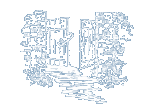



 | 


|
|
The Garter, or Garden, SnakeTeacher's Story
The garters are likely to congregate in numbers in places favorable for hibernation, like rocky ledges or stony side-hills. Here each snake finds a safe crevice, or makes a burrow which sometimes extends a yard or more under ground. During the warm days of Indian summer, these winter hermits crawl out in the middle of the day and sun themselves, retiring again to their hermitages when the air grows chilly toward night; and when the cold weather arrives, they go to sleep and do not awaken until the first warm days of spring; then, if the sun shines hot, they crawl out and bask in its welcome rays. After the warm weather comes, the snakes scatter to other localities more favorable for finding food, and thus these hibernating places are deserted during the summer. The banks of streams, and the edges of woods are places which furnish snakes their food, which consists of earthworms, insects, toads, salamanders, frogs, etc. The young are born late in July and are about six inches long at birth; one mother may have in her brood from eleven to fifty snakelings; she stays with them during the fall to protect them, and there are many stories about the way the young ones run down the mother's throat in case of attack; but, as yet, no scientist has seen this act, or placed it on record. The little snakes shift for their own food, catching small toads, earthworms and insects. If it finds food in plenty, the garter snake will mature in one year. Hawks, crows, skunks, weasels and other predacious animals seem to find the garter snake attractive food.
Lesson XLIXThe Garter, or Garden, SnakeLeading thought—The garter snake is a common and harmless little creature and has many interesting habits which are worth studying. Method—A garter snake may be captured and placed in a box with a glass cover and thus studied in detail in the schoolroom, but the lesson should begin with observations made by the children on the snakes in their native haunts. Observations— 1. What are the colors and markings of your garter snake? Do the stripes extend along the head as well as the body? How long is it? 2. Describe its eyes, its ears, its nostrils and its mouth. 3. If you disturb it how does it act? Why does it thrust its tongue out? What shape is its tongue? 4. In what position is the snake when it rests? Can you see how it moves? Look upon the lower side. Can you see the little plates extending crosswise? Do you think it moves by moving these plates? Let it crawl across your hand, and see if you can tell how it moves. 5. What does the garter snake eat? Did you ever see one swallow a toad? A frog? Did it take it head first or tail first? 6. Where does the garter spend the winter? How early does it appear in the spring? 7. At what time of year do you see the young snakes? Do the young ones run down the throat of the mother for safety when attacked? Does the mother snake defend her young? 8. What enemies has the garter snake?
|


|


|